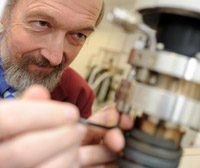Green Heating and Cooling Technology from Carbon
 Carbon is a substance environmentalists love to hate. It is the major ingredient of environmental damage. Scientists and environmentalists are working hard to decrease the amount of carbon emission in the environment. But researchers at the University of Warwick have invented a complete different use of carbon. They are using carbon for cooling and heating our cars and homes. If one follows their way, carbon can be utilized in a clean and green way. We know that heating and cooling gadgets make our life comfortable but they are not easy on our pockets. They need lots of power to run and ultimately get transformed into huge amount of bills to pay. If we look at the stats we will find that domestic space heating and hot water devour 25% of energy in the UK. Automobile air conditioning uses about 5% of the vehicle fuel consumed annually all over the EU. Inside the UK, it is responsible for over 2 million tonnes of CO2 emissions.
Carbon is a substance environmentalists love to hate. It is the major ingredient of environmental damage. Scientists and environmentalists are working hard to decrease the amount of carbon emission in the environment. But researchers at the University of Warwick have invented a complete different use of carbon. They are using carbon for cooling and heating our cars and homes. If one follows their way, carbon can be utilized in a clean and green way. We know that heating and cooling gadgets make our life comfortable but they are not easy on our pockets. They need lots of power to run and ultimately get transformed into huge amount of bills to pay. If we look at the stats we will find that domestic space heating and hot water devour 25% of energy in the UK. Automobile air conditioning uses about 5% of the vehicle fuel consumed annually all over the EU. Inside the UK, it is responsible for over 2 million tonnes of CO2 emissions. To see how Klean Industries is developing environmentally friendly, cost effective carbon solutions, please click here.
Researchers at the University of Warwick are trying to find out clean and green solutions to the above mentioned problems. They are devising new ways to save energy and reduce global warming.
If we are using even the finest condensing boilers at homes they are about 90% efficient. If we are opting out for electric heat pumps that use electricity to pull out heat from the outside air or the ground to keep our houses warm, the electricity consumed results in huge CO2 production at the power station.
Researchers are trying to devise a novel way of using adsorption technology to heat and cool our houses and cars. They utilize the heat from a gas flame or engine waste heat to power a closed system containing only active carbon and refrigerant. It works in a simple manner. At room temperature carbon adsorbs the refrigerant and when heated the refrigerant is driven out. This is a procedure that alternately heats and cools the carbon. This procedure can be used to remove heat from the outside air and put it into radiators or hot water tanks. It works in opposite manner for air conditioning cars. It extracts the heat from the inside of the car. The major hitch of adsorption technology is that it would require roughly 300 liters in volume for an automobile’s air conditioner and bigger for a heat pump to heat the houses. We can’t fit such a device into a car or our houses carrying that huge volume.
University of Warwick researchers have cracked the above mentioned problem of huge volume. They formulated adsorption systems design that significantly shrink these devices. Their devices are small and light enough to be fitted in our houses and cars. They have applied for a patent for their invention. They use thin (0.7mm thick) sheets of metal throughout the active carbon in the heat exchanger. Every sheet holds around hundred tiny water channels (0.3mm in diameter). This makes the heat transfer much more efficient. These water sheets shrink the adsorption based equipment 20 times smaller than was formerly possible.
The University of Warwick engineers are of the view that their new adsorption technology will reduce the electricity up to 30%. They invented device that will utilize the waste automobile heat and cool the interiors. This will not derive any mechanical power from the car engine. So it will result in reduction of fuel consumption and CO2 emissions up to 5%. But here is the cherry on the top. According to the scientists we don’t have to shell out extra money to integrate these equipments into new vehicle models. If it would cost us at all, it will be very little.
Manufacturers are interested in the work of Warwick engineers. Now Warwick Ventures, the university’s technology transfer office, and H2O Venture Partners are setting up a new spin-out company, Sorption Energy Ltd. They are aiming to capture the two high value markets: greener heating and hot water systems for houses and air conditioning for cars.
You can return to the main Market News page, or press the Back button on your browser.

